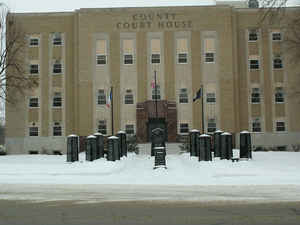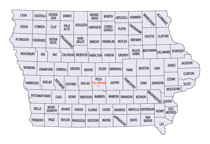Iowa Counties
There are ninety-nine counties in Iowa. The first two counties, Des Moines County and Dubuque County, were created in 1834 when Iowa was still part of the Michigan Territory. In preparation for Michigan's statehood, part of Michigan Territory was formed into Wisconsin Territory in 1836]. Two years later, the western portion was split off to become Iowa Territory. The south-eastern part of Iowa Territory became Iowa, the 29th state in the union, on 28 December 1846, by which point 44 Counties had been created. Counties continued to be created by the state government until 1857, when the last county, Humboldt County, was created.Floyd County, Iowa
Floyd County Education, Geography, and History
Floyd County is a county located in the state of Iowa. Based on the 2010 census, the population was 16,303. Floyd County was created on January 15, 1851. The county seat is Charles City. The county is named in honor of Charles Floyd (1782–1804), the only man to die on the Lewis and Clark Expedition or William Floyd, a signer of the United States Declaration of Independence.
Etymology - Origin of Floyd County Name
Floyd county is named for either William Floyd, a signer of the United States Declaration of Independence, or Charles Floyd, the only man to die on the Lewis and Clark Expedition.
Demographics:
County QuickFacts: CensusBureau Quick Facts
Floyd County History
Floyd County was named in honor of
Sergeant Charles Floyd of the famous Lewis and Clark expedition that was sent up
the Missouri River in 1806. He was the first white man whose death and burial in
Iowa are on record.
The county was established in 1851 and incorporated in 1854. The first election
was held with 85 votes cast. There was an intense rivalry for location of the
county seat between the towns of St. Charles (now Charles City) and Floyd
(geographic center of the county). St. Charles was the first county seat.
David Ripley was elected county judge in 1857 on the campaign pledge that the
county seat would be moved to Floyd. He called an election in 1858, and Floyd
received 453 votes to St. Charles' 434. After the announcement, the boys of St.
Charles marched on Main Street to the public square and lit bonfires, made
speeches, burned an effigy of the county court, and held a mock funeral oration.
The people of St. Charles challenged the legality of the vote. The district
court found the election legal and binding, but the Iowa Supreme Court reversed
the decision and said the county seat was to remain in St. Charles.
Construction continued on the St. Charles courthouse, but those still in favor
of Floyd as a county seat assembled to tear it down. Judge Collins (Ripley's
term had expired) addressed the crowd, saying, "If you tear down this building,
your money will have to rebuild it - if not on this site, then on some other
site.
"Now my advice to you today is to tear it down, not to leave one stone upon
another; and then return home and tear down your own houses, every one of them.
They are yours, and your money has paid for them same as for this." The crowd
dispersed quietly upon hearing this speech.
The stone courthouse was finished in 1861 for less than $18,000. One June 7,
1874, a terrific thunderbolt struck the courthouse. The important county records
were saved.
A local newspaper reported the thunderbolt hit the courthouse "just as the wrath
of an outraged and wronged constituency has descended upon many a nest of
courthouse rates in these latter days. We cannot guess which one of the officers
the lightning was after this time . . ."
The courthouse burned down in 1881, and the question of the county seat was
revived. Loud and long were the speeches for removal - somewhere, anywhere,
just so it moved from Charles City. Charles City once again weathered the storm
and has remained the county seat to this day. A new courthouse was built in 1881
for $25,100. The cornerstone for the present courthouse was laid in 1940. This
courthouse cost $265,000.
In 1901 C.W. Hart and C.H. Parr moved to Charles City and established the Hart
Parr Factory, later changed to White-New Idea Equipment Company. In 1902, the
first Hart Parr gasoline traction engine was finished. One day, Sales Manager
W.H. Williams, puzzling over an advertisement, decided the words "gasoline
traction engine" seemed too long. The word "tractor" popped into his mind and
has been around the world used ever since.
On July 3, 1906, the Floyd County Board of Supervisors ordered the construction
of a foot bridge over the Cedar River to the Chautauqua grounds. The county was
to pay $1,200 toward its construction and Charles City would own and maintain
it. This is the present suspension bridge (one of the oldest in the state) and
was dedicated as a national historic site on July 2, 1990.
The destructive tornado that hit Charles City late in the afternoon of May 15,
1968 left the downtown area in ruins, but the courthouse itself escaped serious
damage. Several trees on the grounds were destroyed, however. The courthouse
served as headquarters for civil defense activities and for the police
department following the tornado.
Carrie Lane Chapman Catt, noted leader in the women's suffrage movement, lived
in and around Charles City for some 20 years.
Source: Marilee Monroe, Floyd County Recorder, 2002
Geography: Land and Water
As reported by the Census Bureau, the county has a total area of 501 square miles (1,300 km2), of which 501 square miles (1,300 km2) is land and 0.8 square miles (2.1 km2) (0.1%) is water
Floyd county is located in northeast Iowa. Wildlife areas Cedar Hills
and Nagle Wildlife Area are located in this county.
Neighboring Counties
Bordering counties are as follows:
- North: Mitchell County
- Northeast: Howard County
- East: Chickasaw County
- Southeast: Bremer County
- South: Butler County
- Southwest: Franklin County
- West: Cerro Gordo County
Education







